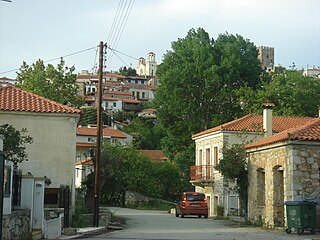Related Research Articles
Harpasa was a city and bishopric in ancient Caria in Roman Asia Minor, which only remains a Latin Catholic titular see.
Euroea in Phoenicia was a city in the late Roman province of Phoenicia Secunda. today Hawarin, north of al-Qaryatayn and on the road from Damascus to Palmyra. There are ruins of a Roman castellum and of a basilica.

Avlonari is a village and a community (unit) of the Municipality Kymi-Aliveri, in the eastern part of the Aegean island of Euboea, Greece. It was the seat of the municipality of Avlon, and the medieval town and bishopric of Aulon, which remains a Latin Catholic titular see.
Arabissus or Arabissos, also known as Tripotamos, was a town in ancient Cataonia, then Cappadocia, and later in the Roman province of Armenia Secunda. The Byzantine Emperor Maurice was born there in 539. A cave of the Seven Sleepers is located in the Eshab-ı Kehf Kulliye.
Caloe was a town in the Roman province of Asia. It is mentioned as Kaloe or Keloue in 3rd-century inscriptions; as Kalose in Hierocles's Synecdemos (660); and as Kalloe, Kaloe, and Kolone in Parthey's Notitiæ episcopatuum, in which it figures from the 6th to the 12fth or 13th century.
Cestrus was a city in the Roman province of Isauria, in Asia Minor. Its placing within Isauria is given by Hierocles, Georgius Cyprius, and Parthey's. While recognizing what the ancient sources said, Le Quien supposed that the town, whose site has not been identified, took its name from the River Cestros and was thus in Pamphylia. Following Lequien's hypothesis, the 19th-century annual publication Gerarchia cattolica identified the town with "Ak-Sou", which Sophrone Pétridès called an odd mistake, since this is the name of the River Cestros, not of a city.
Eudoxias was a city and bishopric in the late Roman province of Galatia Secunda, in Asia Minor.
Temnos or Temnus was a small Greek polis (city-state) of ancient Aeolis, later incorporated in the Roman province of Asia, on the western coast of Anatolia. Its bishopric was a suffragan of Ephesus, the capital and metropolitan see of the province, and is included in the Catholic Church's list of titular sees.
Polystylus is the name of an ancient town and bishopric in the late Roman province of Macedonia Secunda, whose metropolis was Philippi. Its name is given in this form in the Catholic Church's list of titular sees. A 1911 article by Sophrone Pétridès called it Polystylum.
Traianopolis, Trajanopolis, Tranopolis, or Tranupolis was a Roman and Byzantine city in Phrygia Pacatiana Prima.
Trapezopolis or Trapezoupolis (Τραπεζούπολις) was a city of ancient Caria, and later in the late Roman province of Phrygia Pacatiana Prima.
Zenopolis was an ancient Roman and Byzantine city and episcopal see variously placed in Lycia or in neighbouring Pamphylia.
Acarassus or Akarassos was a city in ancient Lycia.
Arneae or Arneai was a small city of ancient Lycia mentioned by Capito in his Isaurica. It is located near Ernes, in the interior of Lycia where archaeological remains have been found.
Eudocia was a town in ancient Lycia.
Eudocias or Eudocia was an ancient town in the Roman province of Pamphylia Secunda, in the neighbourhood of Termessus.
Meloë was a town in ancient Lycia, located near Cape Kilidonia.
Carallia was a city of the Roman province of Pamphylia Prima and is mentioned in the acts of the Council of Ephesus (431). The same form of the name is given in the acts of the Council of Chalcedon (451).

Justinianopolis in Armenia also known as Iustinianopolis was a Roman and Byzantine era city and bishopric in Lesser Armenia. It has been identified with modern Erzincan, Turkey. It was one of several ancient sites renamed in late Antiquity after Byzantine emperor Justinian I. The city also known as Acilisene and Keltzene.
Limnae (in Pisidia) was a city and bishopric in the Roman province of Pisidia (Asia Minor), which is now a Latin Catholic titular see.
References
- ↑ Annuario Pontificio 2013 (Libreria Editrice Vaticana 2013 ISBN 978-88-209-9070-1), "Sedi titolari", pp. 819-1013
 This article incorporates text from a publication now in the public domain : Herbermann, Charles, ed. (1913). "Hauara". Catholic Encyclopedia . New York: Robert Appleton Company. The entry cites:
This article incorporates text from a publication now in the public domain : Herbermann, Charles, ed. (1913). "Hauara". Catholic Encyclopedia . New York: Robert Appleton Company. The entry cites:- Le Quien, Michel (1740). Oriens Christianus, in quatuor Patriarchatus digestus: quo exhibentur ecclesiæ, patriarchæ, cæterique præsules totius Orientis. Tomus secundus, in quo Illyricum Orientale ad Patriarchatum Constantinopolitanum pertinens, Patriarchatus Alexandrinus & Antiochenus, magnæque Chaldæorum & Jacobitarum Diœceses exponuntur (in Latin). Paris: Ex Typographia Regia. col. 11507. OCLC 955922747.